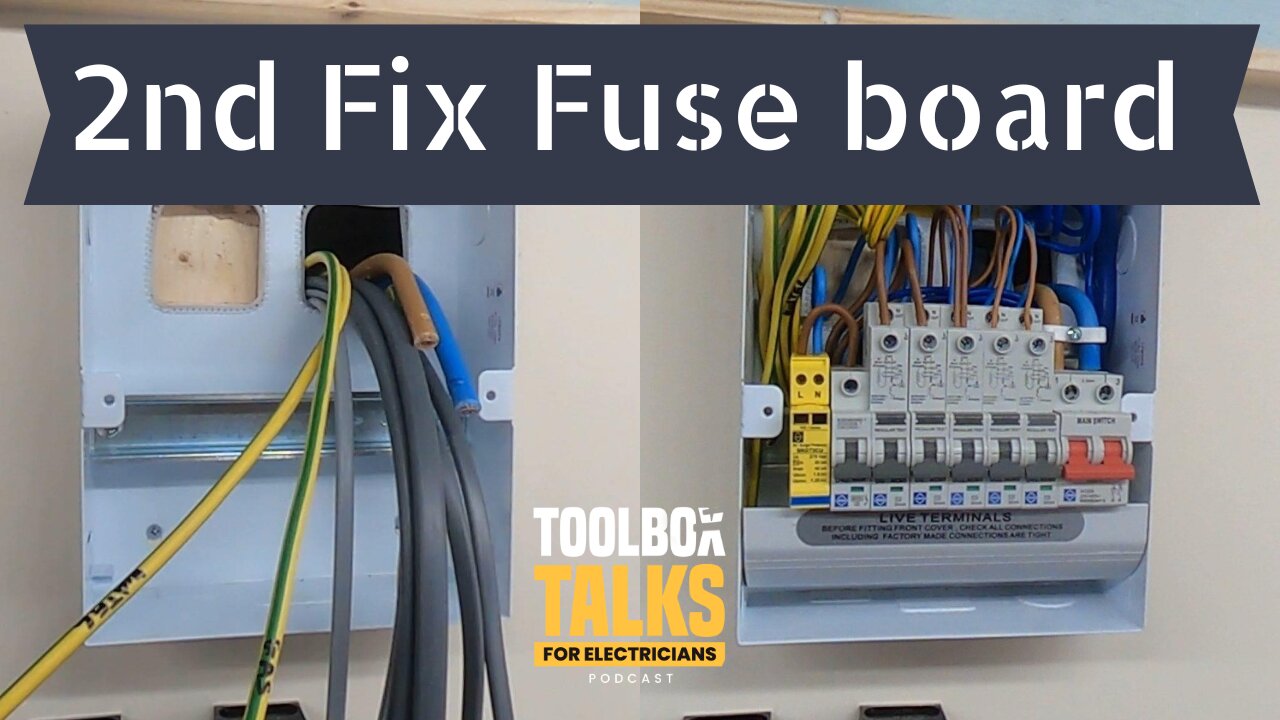Premium Only Content

How To 2nd Fix A Fuse Board With SPD Tutorial 🧑🔧
Second-fixing a fuse board, also known as a consumer unit in the UK, is the process of making the final connections, ensuring everything is in its proper place, and testing the unit for safe operation. Here's a step-by-step guide to second-fixing a fuse board. Please note that this is a simplified overview, and working with electrical installations should only be done by qualified individuals:
Safety First: Always ensure the main power supply is turned off before working on a fuse board. It's best to use a voltage tester to double-check there's no current flowing to the board.
Mount the Consumer Unit: If not already in place, mount the consumer unit securely to the wall.
Install Circuit Breakers:
Slot in the necessary circuit breakers (MCBs, RCCBs, or RCBOs) according to the planned layout of circuits.
Make sure each breaker matches the current rating for its specific circuit.
Connect the Main Earth and Neutral Bars:
Attach the main earth (ground) wire to the earth bar.
Connect the neutral wires from the different circuits to the neutral busbar.
Connect the Live Wires:
Connect the live wires from the different circuits to their respective circuit breakers.
Connect the Main Live and Neutral:
Attach the main live wire (coming from the electricity meter or main cut-off switch) to the main switch or RCD of the consumer unit.
Attach the main neutral wire to the neutral bar.
Neatness and Management:
Use cable trunking or conduit, if necessary, to manage and protect wires leading into the consumer unit.
Ensure cables are neatly organized within the consumer unit, with no excess slack.
Labelling: Clearly label each circuit breaker with its corresponding area or appliance (e.g., "kitchen sockets," "upstairs lights").
Testing: Before powering on, use a continuity tester to check connections. Once powered on, use a loop impedance tester and insulation resistance tester to ensure everything is safe. Check RCDs with an RCD tester.
Power On: Once satisfied with all connections and initial tests, switch the main power back on and check each circuit's functionality.
Final Checks and Certification:
Conduct final safety checks.
In the UK, electrical work must adhere to the Wiring Regulations (BS 7671). After installation, it is necessary to fill out an Electrical Installation Certificate or Minor Work Certificate, as appropriate, and have the installation checked by a qualified person or inspector.
Warning: Working on a consumer unit and electrical circuits can be hazardous. Always consult with, or hire, a qualified electrician. Electrical installations in the UK must meet specific regulatory standards, and unauthorized or incorrect installations can be both illegal and dangerous.
-
 1:09
1:09
Tool Box Talk For Electricians
8 days ago🎁 Electrician’s Wishlist: Forget Socks – We Want TOOLS! 🛠️⚡
141 -
 1:23:41
1:23:41
Game On!
17 hours ago $3.23 earnedNetflix NFL Christmas Games Preview and Predictions!
19.7K4 -
 2:05:07
2:05:07
Darkhorse Podcast
21 hours agoWhy Trump Wants Greenland: The 257th Evolutionary Lens with Bret Weinstein and Heather Heying
259K413 -
 8:50:58
8:50:58
Right Side Broadcasting Network
21 hours ago🎅 LIVE: Tracking Santa on Christmas Eve 2024 NORAD Santa Tracker 🎅
280K37 -
 2:48
2:48
Steven Crowder
1 day agoCROWDER CLASSICS: What’s This? | Nightmare Before Kwanzaa (Nightmare Before Christmas Parody)
267K12 -
 33:49
33:49
Quite Frankly
20 hours agoThe Christmas Eve Midnight Telethon
71.4K9 -
 2:12:46
2:12:46
Price of Reason
20 hours agoAmber Heard BACKS Blake Lively Lawsuit Against Justin Baldoni! Is Disney CEO Bob Iger in TROUBLE?
35.7K13 -
 1:01:17
1:01:17
The StoneZONE with Roger Stone
14 hours agoChristmas Edition: Why the Panama Canal is Part of the America First Agenda | The StoneZONE
110K42 -
 18:12:15
18:12:15
LFA TV
1 day agoLFA TV CHRISTMAS EVE REPLAY
128K14 -
 13:32
13:32
Scammer Payback
15 hours agoChanging the Scammer's Desktop Background to his Location
2.87K3